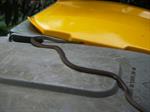
The Rubbish can wait till the snake has gone.
Snakes are on the move early around Australia after winter this year.
I heard a snake catcher comment that 95% of snake bites occur when people attack or try to catch or interact with a snake.
Not all snakes are poisonous. Some are deadly; but others will not dso any seriouis damage eveen if they do bite.
Most snakes are predators of vermin though. They help control rats and mice; insects and other pests that we might not want around. In some respects they are important and beneficial animals to have around. As long as you keep out of their way, they tend to keep out of your way.
How Much Do you know about Snakes?
What is Venom?
Many members of the Squamata order use venom as a method to subdue prey. There is a range of morphological features and effectiveness of venom between species. The Elapids (eg. King Brown Snake), Viperids (eg. Rattlesnake), Helodermatidae (Gila Monster) are all venomous. Some colubrids (eg. Mangrove Snake) are also venomous. Venom can serve two functions of subduing prey by either anaesethetising or killing the animal. It is in the snake’s interest to subdue the prey as soon as possible to lessen the risk of harm to itself as well as reducing energy expenditure. Some species of Viperid have proteolytic enzymes in their venom which has the added benefit of aiding digestion.
Biting and Grasping
Carnivorous reptiles usually catch prey by pursuing and grasping with their jaws. They may also use striking attacks during an ambush attack. Varanid lizards (eg. Nile Monitor) and turtles with long flexible necks along with snakes regularly use the striking attack as a preferred method of capturing prey. When striking, the animal does not open its mouth until the head comes into contact with the prey. When contact is made the pressure on the teeth triggers the mouth to close quickly.
Some may then use cyclic movements of the tongue to move food to the back of the mouth. Food is moved to the oesophagus by moving the tongue forward beneath the food, lifting the food and then retracting. Surface bonding is important in this type of feeding and as the prey or food size gets larger, the bonding mechanisms must increase (i.e. increased surface contact between the tongue and the food). Larger tongues can be a disadvantage to some reptiles as this decreases the gape size, therefore reducing the jaw grip.
Most carnivorous reptiles do not process their prey in the mouth when using this method. Most will swallow their prey whole. Herbivorous reptiles (such as Iguanas and Tortoises) will process food in the mouth. However, this is minimal. The teeth can crush or pierce the food, but it is swallowed whole.